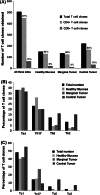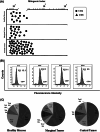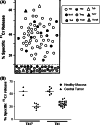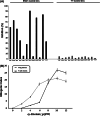Ex vivo analysis of pancreatic cancer-infiltrating T lymphocytes reveals that ENO-specific Tregs accumulate in tumor tissue and inhibit Th1/Th17 effector cell functions
- PMID: 23640603
- PMCID: PMC11028529
- DOI: 10.1007/s00262-013-1429-3
Ex vivo analysis of pancreatic cancer-infiltrating T lymphocytes reveals that ENO-specific Tregs accumulate in tumor tissue and inhibit Th1/Th17 effector cell functions
Abstract
Pancreatic cancer (PC) is an aggressive disease with dismal prognosis. Surgical resection is the recommended treatment for long-term survival, but patients with resectable PC are in the minority (with a 5-year survival rate of 20 %). Therefore, development of novel therapeutic strategies, such as anti-PC immunotherapy, is crucial. α-Enolase (ENO1) is an enzyme expressed on the surface of pancreatic cancer cells and is able to promote cell migration and cancer metastasis. The capacity of ENO1 to induce an immune response in PC patients renders it a true tumor-associated antigen. In this study, we characterized the effector functions of ENO1-specific T cells isolated from PC patients, and we specifically evaluated the successful role of intra-tumoral T helper 17 (Th17) cells and the inhibitory role of regulatory T (Tregs) cells in respectively promoting or reducing the cancer-specific immune response. In this ex vivo study, we have demonstrated, for the first time, that ENO1-specific Th17 cells have a specific anti-cancer effector function in PC patients, and that there are decreased levels of these cells in cancer compared to healthy mucosa. Conversely, there are elevated levels of ENO1-specific Tregs in PC patients which lead to inhibition of the antigen-specific effector T cells, thus highlighting a possible role in promoting PC progression. These results may be relevant for the design of novel immunotherapeutic strategies in pancreatic cancer.
Conflict of interest statement
The authors declare that they have no conflict of interest.
Figures





References
-
- Laheru D, Lutz E, Burke J, Biedrzycki B, Solt S, Onners B, Tartakovsky I, Nemunaitis J, Le D, Sugar E, Hege K, Jaffee E. Allogeneic granulocyte macrophage colony-stimulating factor-secreting tumor immunotherapy alone or in sequence with cyclophosphamide for metastatic pancreatic cancer: a pilot study of safety, feasibility, and immune activation. Clin Cancer Res. 2008;14:1455–1463. doi: 10.1158/1078-0432.CCR-07-0371. - DOI - PMC - PubMed
-
- Ramanathan RK, Lee KM, McKolanis J, Hitbold E, Schraut W, Moser AJ, Warnick E, Whiteside T, Osborne J, Kim H, Day R, Troetschel M, Finn OJ. Phase I study of a MUC1 vaccine composed of different doses of MUC1 peptide with SB-AS2 adjuvant in resected and locally advanced pancreatic cancer. Cancer Immunol Immunother. 2005;54:254–264. doi: 10.1007/s00262-004-0581-1. - DOI - PMC - PubMed
Publication types
MeSH terms
Substances
LinkOut - more resources
Full Text Sources
Other Literature Sources
Medical
Miscellaneous

